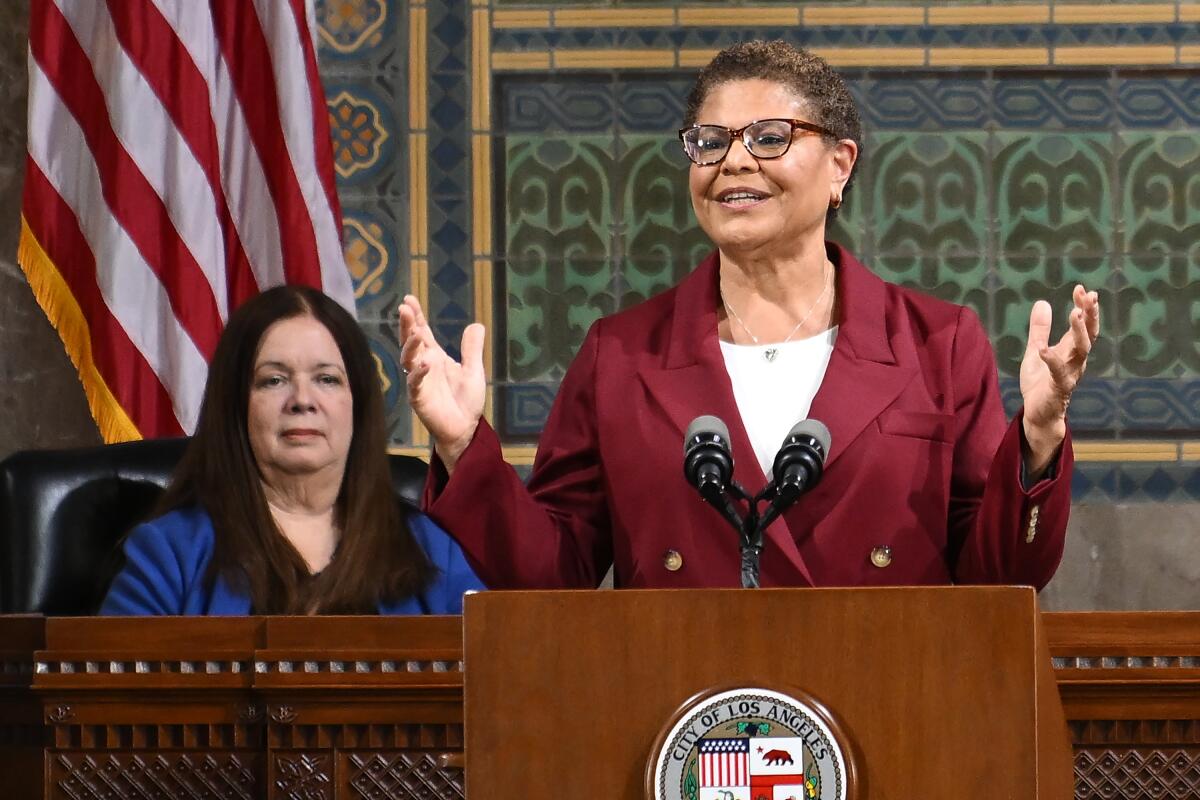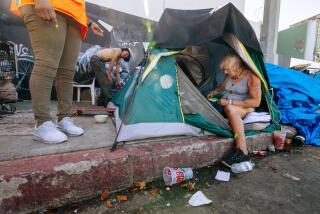Mayor Bass seeks $250-million expansion of homelessness program in first State of the City speech

- Share via
In her first State of the City speech, Mayor Karen Bass announced a dramatic expansion of her signature program to move homeless people indoors, while also pledging to create “a new L.A.”
Bass said she intends to propose $250 million for Inside Safe, which has been moving unhoused residents off sidewalks and into hotel and motel rooms, as part of a $1.3-billion investment in housing and homelessness programs — an amount she called “unprecedented.”
The mayor’s full spending plan, which will cover the fiscal year that starts July 1 and still requires City Council approval, will be unveiled Tuesday morning.
In the four months since she took office, Bass has at times seemed like a single-issue mayor, focusing almost exclusively on homelessness. Monday’s speech foregrounded those efforts, while turning attention toward public safety and other topics.
Bass pledged to rebuild the ranks of the Los Angeles Police Department, while also investing in a new Office of Community Safety, which will focus on unarmed responses to emergencies. The mayor’s speech touched on a laundry list of other topics, including climate change, paramedic response times, pothole repairs, vacancies in the city workforce and graffiti on freeways and underpasses.
Depending on the specifics of her spending plan, the mayor’s proposed budget will likely allocate more money to addressing the homelessness crisis than in previous years.
Two years ago, then-Mayor Eric Garcetti used his own State of the City address to announce nearly $1 billion to reduce homelessness, which has steadily grown over the past decade.
Speaking in City Hall’s council chambers to a packed room of civic and community leaders, Bass began by saying she could not declare that the state of the city is “where it needs to be.” She proffered a vision of a metropolis defined by neighborhood-level issues that her administration is just beginning to tackle.
The state of the city hinges largely on conditions in each neighborhood and each household, Bass said.
“Do you [not have to] look over your shoulder when walking after dark? Do you feel pride in your local park? Do you have peace of mind because you can actually pay the rent? When the answer is yes, then we can say the state of our city is strong,” she said.
Unlike Garcetti, who favored sweeping language and delivered his final State of the City address under the undulating concrete ribbons of the Sixth Street Bridge, Bass’ style was straightforward and largely devoid of rhetorical flourishes.
Bass’ chosen backdrop doubled as a different kind of panoramic metaphor.
With the City Council, the city attorney and the city controller seated nearby, Bass presented a tableau of orderly government collaboration. The visual provided a sharp contrast to the disorder that dominated council meetings last year in the wake of a leaked racist audio recording.
Since taking office in December, Bass has emphasized the need to work closely with other government agencies to solve homelessness and other regionwide problems, relying on the phrase “locking arms.” As part of that theme, Bass allowed leaders of the City Council and the County Board of Supervisors to speak at Monday’s event, when the mayor is typically the only speaker.
Council President Paul Krekorian and Board Chair Janice Hahn’s introductions were emblematic not just of Bass’ broader approach but also the realities of governing in Los Angeles, said Raphael Sonenshein, executive director of the Pat Brown Institute for Public Affairs at Cal State LA.
“Any mayor is the most recognized political leader,” Sonenshein said. “But it’s really hard on some issues to get things done without the City Council, who elect the council president and, to some degree, the county supervisors whenever there’s social services involved, as would be the case on homelessness.”
It’s an understanding that Bass — a former Assembly speaker and six-term member of Congress — is deeply familiar with, and one that echoed throughout her speech in nods to her city and county colleagues.
Bass used her speech to highlight her work so far in combating homelessness: declaring a state of emergency, encouraging other city and county officials to do the same, searching for city-owned land to house people and seeking new funding from state and federal agencies.
“We have finally dispelled the myth that people do not want to come inside,” Bass said of her plans to expand Inside Safe.
Since its launch four months ago, the program has arrived at roughly a dozen locations, including Venice, Hollywood, Echo Park and South Los Angeles. In the coming year, Bass said, it will focus not just on renting hotel and motel rooms but also on purchasing buildings outright.
Still, some homeless advocates voiced alarm that the mayor is seeking such a massive expansion — a fivefold increase over the amount provided to the program early in her administration. In recent days, they have created a website highlighting what they say are the program’s failures.
Mutual aid groups, which provide tents, blankets and other resources to L.A.’s unhoused, have criticized the mayor’s team for moving some Inside Safe participants from hotel to hotel, or placing them in rooms far from the neighborhoods where they have been living.
In some instances, those advocates said, Inside Safe facilities have lacked adequate social services, such as mental health professionals and substance-use counselors.
“This program seems so much more about clearing the sidewalk, rather than the quality of life of people going into Inside Safe,” said Carla Orendorff, who advocates on behalf of unhoused residents living in the San Fernando Valley.
Bass’ homelessness team has said they’re learning lessons as they carry out more and more encampment cleanups. They said some Inside Safe participants were relocated after the mayor’s team learned that their motel conditions were substandard.
Bass also declared her plans to rebuild the police department, saying she feared the department’s ranks might fall below 9,000 officers — a low not seen since 2002, according to her. She promised an urgent new recruitment campaign aimed at hiring police officers, saying that financial incentives would be provided to city employees who help find recruits.
She also spoke of her plans for the new Mayor’s Office of Community Safety, saying it will allow “community intervention workers, social workers, clinical psychologists and other experts to respond when law enforcement is not required.” She said that approach will save lives and save money.
Councilmember Tim McOsker, who represents neighborhoods near the port, as well as Watts, said after the speech that he supports Bass’ emphasis on rebuilding LAPD staffing.
“We share the same goal of recruiting and retaining officers, even while we work to expand on our unarmed crisis response programs,” he said. “These efforts should not be mutually exclusive.”
Others voiced dismay at the plan for more LAPD officers.
“I’m disappointed by her emphasis on hiring more police and getting more police on the streets,” said Black Lives Matter L.A. co-founder Melina Abdullah.
Bass acknowledged ongoing problems at the city’s animal shelters by bluntly stating that the city’s care of the animals is “not working well.” She said her budget would include money for additional staff at the agency.
The mayor also announced a plan to hire hundreds of Los Angeles city firefighters. She plans to allow qualified paramedics to work immediately and complete their firefighter instruction later — a move meant to address the vast majority of calls that are for medical emergencies.
More to Read
Sign up for Essential California
The most important California stories and recommendations in your inbox every morning.
You may occasionally receive promotional content from the Los Angeles Times.













